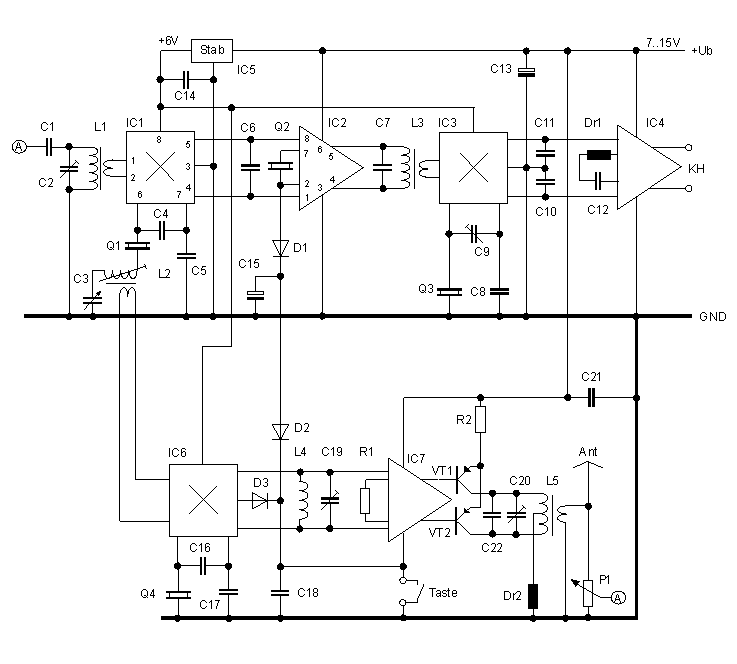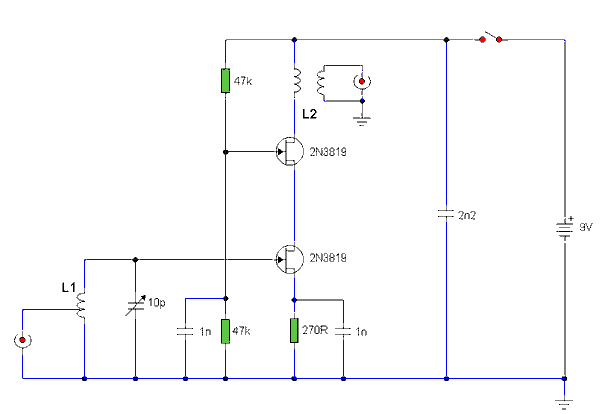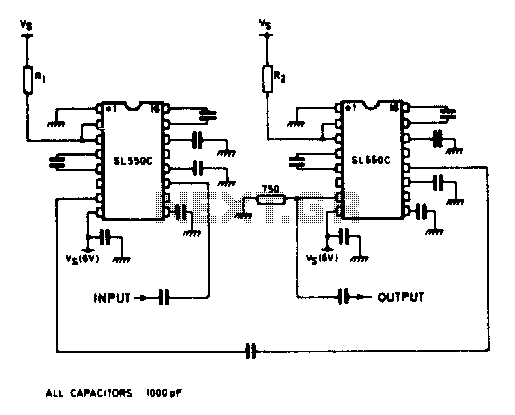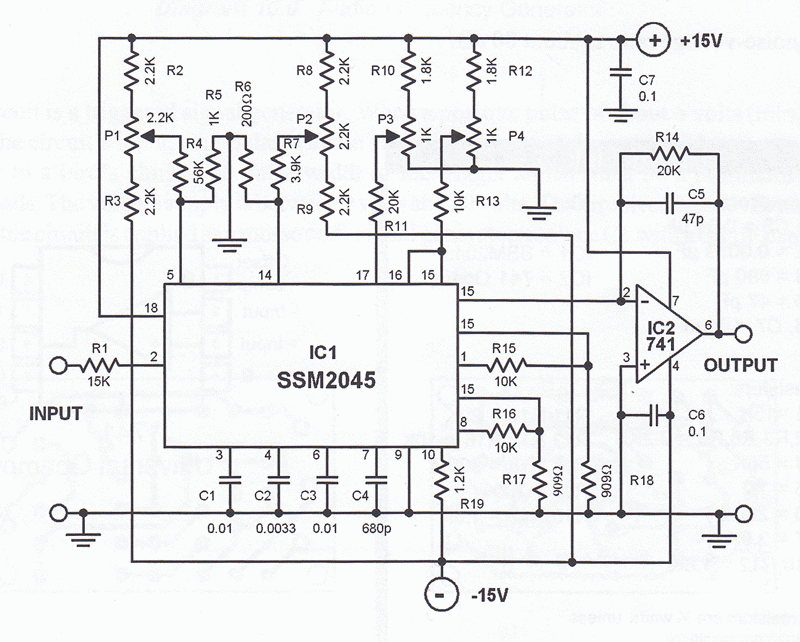
30m Band CW-Transceiver

This simple QRP transceiver for the 30 m band did not result from a detailed requirement profile. I simply had some NE592 broadband amplifiers in my junk box, waiting for an application. After performing some tests, that application was quickly found: The amps should become part of a superhet transceiver. There is need for amplification in several places in such a rig, starting from the IF, over to the AF, and up to the RF for driving a push-pull final. The high crystal frequency of 14318 kHz allows a pulling range of 20 kHz without special tricks. You can tune the reception range from 10100 kHz to 10120 kHz using the coil L2. Some tests with the number of turns of the coil are recommended here, such tests are commonplace when setting up a VXO. The oscillator signal is coupled into the transmitter mixer through a small link winding on L2, so the Tx mixer can be driven symmetrically. I first tried a capacitive connection, for example 10 pF at pin 7 of IC 1, but found that too much of the rig's own radiated RF got picked up that way. The Rx mixer is followed by a IF stage featuring an NE592. The mixer's balanced output is directly connected to the amplifier's differential input, minimizing component count at this point. I got a sufficiently narrow bandpass action for the selection of the intermediate frequency using a single 4194 kHz crystal as the only Z element.
Product detector and AF amplifier
The second mixer operates as a product detector. It is followed by a NE592-based selective audio amplifier. The RF portion of the mixer's output signal is suppressed by the two capacitors C10/C11. The remaining AF signal is directly fed into the differential input of the NE592.
The AF stage's frequency response is determined by the series resonant circuit DR1/C12. The stage has a gain of 42 dB at a measured center frequency 660 Hz. The volume adjustment takes place with the RF attenuator P1 close to the antenna input.
Headphones with an impedance of at least 1 kOhm are mandatory here, due to the relatively high output impedance of the NE592. A LM386 is actually the preferential component for driving headphones, or an 8 ohms loudspeaker. But I wanted to try something different this time.
Tx mixer, driver and power amplifier
A NE592 does its job also here. Due to its relatively high input impedance, it can be attached directly to the parallel resonant circuit L4/C19. Its 8 mW power output of the broadband amp is sufficient to drive a small push-pull transistor stage. To align the transceiver, an existing main-station rig and an oscilloscope are sufficient. First tune the VXO frequency with L2 to 14.294 kHz (C3 max.) and 14.314 kHz (C3 min.). Now tune the input resonant circuit with C2 to 10110 kHz; i.e., max. volume of an amateur radio station working on this frequency. C9 determines the BFO frequency offset and thus the pitch of the AF signal. For maximum AF output level, the frequency offset of the BFO should correspond with the resonant frequency from C12/DR1.
Next, the two trimmer capacitors in the transmitter section are adjusted, first C19 and then C20, on best sine wave and maximum output power, respectively. With a supply voltage of Ub=13.8 V, approximately 25 Vss should be delivered to a 50 ohm dummy. Subsequently, check the value with an adapted antenna. However, the signal may look somewhat noisy, due to superimposed received signals getting in from the antenna. Parts No. Value R1 1 kOhm R2 10 Ohm P1 2.2 kOhm, linear C1 3.3 pF C2, 9, 19, 20 5 .. 90 pF trimmer cap C3 20 ... 320 pF variable broadcast capacitor C4, 5, 6 56 pF C7 330 pF C8, 17, 22 220 pF C10, 11 1.8 nF C12 2.2 µF C13 100 µF, 25 V C14, 18, 21 0.1 µF C15 47 µF, 16 V C16 100 pF L1 T50-2, 30 t primary 3 t secondary L2 Diameter=4 mm, Height=12 mm, approx. 2 x 16 t and 3 t (RF pick up) L3 T37-6, 35 t primary 5 t secondary L4 T37-6, 35 t L5 T44-2, 5 t bifilar primary 5 t secondary Dr1 33 mH Dr2 FT37-43, 16 t Q1 14318 kHz Q2, 3, 4 4194.3 kHz D1, 2 BAT 42 D3 1N4148 VT1, 2 2N3906 with a small heat sink IC1, 3, 6 NE612 DIP IC2, 4, 7 NE592-N8 DIP IC5 78L06 KH Headphones Ri > 1 kOhm One pair of PNP transistors 2N3906, together with the tuned tank circuit C20/C22/L5, produce an optically clean sine wave. A measurement of the output spectrum showed the second harmonic to be down -70 dB and the third -37 dB, when compared to the power output at the fundamental frequency. The maximum power output is about 1.5 W when the unit is supplied with Ub=13.8 V.
The described QRP transceiver operates within the 30 m band, utilizing a superheterodyne architecture for effective signal processing. The core components include NE592 broadband amplifiers strategically placed throughout the circuit to provide necessary amplification at various stages: RF, IF, and AF. The transceiver employs a high-frequency crystal oscillator at 14318 kHz, facilitating a tuning range of 20 kHz, which is critical for adjusting reception within the specified range of 10100 kHz to 10120 kHz through coil L2.
The oscillator signal is coupled to the transmitter mixer via a link winding on L2, ensuring symmetrical driving of the Tx mixer. The choice of a capacitive coupling method initially resulted in excessive RF interference, prompting a redesign to enhance signal integrity. The Rx mixer feeds into an NE592-based IF stage, where the balanced output is directly connected to the amplifier's differential input, thus optimizing component usage.
The product detector functionality is provided by the second mixer, followed by an audio amplifier that utilizes NE592 for selective amplification. This stage effectively suppresses RF components, allowing only the AF signal to pass through for further processing. The frequency response of the AF stage is shaped by a resonant circuit, ensuring a gain of 42 dB at a center frequency of 660 Hz.
For headphone output, an impedance of at least 1 kOhm is required due to the NE592's output characteristics. While a LM386 could be employed for driving lower impedance loads, the design opts for a unique audio output approach.
In the transmitter section, the NE592 again serves as a driver, interfacing with a parallel resonant circuit to deliver sufficient power to a push-pull transistor stage. Alignment procedures involve tuning the VXO frequency and adjusting resonant circuits to achieve optimal performance. The output power is calibrated to approximately 25 Vss into a 50-ohm load, ensuring reliable operation when connected to an antenna.
The component list provides a comprehensive overview of the necessary parts, including resistors, capacitors, inductors, diodes, and transistors, highlighting the design's focus on simplicity and efficiency. The transceiver's output spectrum demonstrates impressive harmonic suppression, indicating a well-designed circuit capable of delivering clean, effective signals for amateur radio communications.This simple QRP transceiver for the 30 m band did not result from a detailed requirement profile. I simply had some NE592 broadband amplifiers in my junk box, waiting for an application. After performing some tests, that application was quickly found: The amps should become part of a superhet transceiver. There is need for amplification in several places in such a rig, starting from the IF, over to the AF, and up to the RF for driving a push-pull final.
The high crystal frequency of 14318 kHz allows a pulling range of 20 kHz without special tricks. You can tune the reception range from 10100 kHz to 10120 kHz using the coil L2. Some tests with the number of turns of the coil are recommended here, such tests are commonplace when setting up a VXO. The oscillator signal is coupled into the transmitter mixer through a small link winding on L2, so the Tx mixer can be driven symmetrically. I first tried a capacitive connection, for example 10 pF at pin 7 of IC 1, but found that too much of the rig's own radiated RF got picked up that way.
The Rx mixer is followed by a IF stage featuring an NE592. The mixer's balanced output is directly connected to the amplifier's differential input, minimizing component count at this point. I got a sufficiently narrow bandpass action for the selection of the intermediate frequency using a single 4194 kHz crystal as the only Z element.
Product detector and AF amplifier The second mixer operates as a product detector. It is followed by a NE592-based selective audio amplifier. The RF portion of the mixer's output signal is surpressed by the two capacitors C10/C11. The remaining AF signal is directly fed into the differential input of the NE592. The AF stage's frequency response is determined by the series resonant circuit DR1/C12. The stage has a gain of 42 dB at a measured center frequency 660 Hz. The volume adjustment takes place with the RF attenuator P1 close to the antenna input. Headphones with an impedance of at least 1 kOhm are mandatory here, due to the relatively high output impedance of the NE592. A LM386 is actually the preferential component for driving headphones, or a 8 ohms loudspeaker. But I wanted to try something different this time. Tx mixer, driver and power amplifier A NE592 does its job also here. Due to its relatively high input impedance, it can be attached directly to the parallel resonant circuit L4/C19.
Its 8 mW power output of the broadband amp is sufficient to drive a small push-pull transistor stage. To align the transceiver, an existing main-station rig and an oscilloscope are sufficient. First tune the VXO frequency with L2 to 14.294 kHz (C3 max.) and 14.314 kHz (C3 min.). Now tune the input resonant circuit with C2 to 10110 kHz; i.e., max. volume of an amateur radio station working on this frequency. C9 determines the BFO frequency offset and thus the pitch of the AF signal. For maximum AF output level, the frequency offset of the BFO should correspond with the resonant frequency from C12/DR1.
Next, the two trimmer capacitors in the transmitter section are adjusted, first C19 and then C20, on best sine wave and maximum output power, respectively. With a supply voltage of Ub=13.8 V, approximately 25 Vss should be delivered to a 50 ohm dummy. Subsequently, check the the value with an adapted antenna. However, the signal may look somewhat noisy, due to superimposed received signals getting in from the antenna.
Parts No. Value R1 1 kOhm R2 10 Ohm P1 2,2 kOhm , linear C1 3,3 pF C2, 9, 19, 20 5 .. 90 pF trimmer cap C3 20 ... 320 pF variable broadcast capacitor C4, 5, 6 56 pF C7 330 pF C8, 17, 22 220 pF C10, 11 1,8 nF C12 2,2 µF C13 100 µF, 25 V C14, 18, 21 0,1 µF C15 47 µF, 16 V C16 100 pF L1 T50-2, 30 t primary 3 t secondary L2 Diameter=4 mm, Hight=12 mm, approx. 2 x 16 t and 3 t (RF pick up) L3 T37-6, 35 t primary 5 t secondary L4 T37-6, 35 t L5 T44-2, 5 t bifilar primary 5 t secondary Dr1 33 mH Dr2 FT37-43, 16 t Q1 14318 kHz Q2, 3, 4 4194,3 kHz D1, 2 BAT 42 D3 1N4148 VT1, 2 2N3906 with a small heat sink IC1, 3, 6 NE612 DIP IC2, 4, 7 NE592-N8 DIP IC5 78L06 KH Headphones Ri > 1 kOhm One pair of PNP transistors 2N3906, together with the tuned tank circuit C20/C22/L5, produce an optically clean sine wave.
A measurement of the output spectrum showed the second harmonic to be down -70 dB and the third -37 dB, when compared to the power output at the fundamental frequency. The maximum power output is about 1.5 W when the unit is supplied with Ub=13.8 V. 🔗 External reference
Product detector and AF amplifier
The second mixer operates as a product detector. It is followed by a NE592-based selective audio amplifier. The RF portion of the mixer's output signal is suppressed by the two capacitors C10/C11. The remaining AF signal is directly fed into the differential input of the NE592.
The AF stage's frequency response is determined by the series resonant circuit DR1/C12. The stage has a gain of 42 dB at a measured center frequency 660 Hz. The volume adjustment takes place with the RF attenuator P1 close to the antenna input.
Headphones with an impedance of at least 1 kOhm are mandatory here, due to the relatively high output impedance of the NE592. A LM386 is actually the preferential component for driving headphones, or an 8 ohms loudspeaker. But I wanted to try something different this time.
Tx mixer, driver and power amplifier
A NE592 does its job also here. Due to its relatively high input impedance, it can be attached directly to the parallel resonant circuit L4/C19. Its 8 mW power output of the broadband amp is sufficient to drive a small push-pull transistor stage. To align the transceiver, an existing main-station rig and an oscilloscope are sufficient. First tune the VXO frequency with L2 to 14.294 kHz (C3 max.) and 14.314 kHz (C3 min.). Now tune the input resonant circuit with C2 to 10110 kHz; i.e., max. volume of an amateur radio station working on this frequency. C9 determines the BFO frequency offset and thus the pitch of the AF signal. For maximum AF output level, the frequency offset of the BFO should correspond with the resonant frequency from C12/DR1.
Next, the two trimmer capacitors in the transmitter section are adjusted, first C19 and then C20, on best sine wave and maximum output power, respectively. With a supply voltage of Ub=13.8 V, approximately 25 Vss should be delivered to a 50 ohm dummy. Subsequently, check the value with an adapted antenna. However, the signal may look somewhat noisy, due to superimposed received signals getting in from the antenna. Parts No. Value R1 1 kOhm R2 10 Ohm P1 2.2 kOhm, linear C1 3.3 pF C2, 9, 19, 20 5 .. 90 pF trimmer cap C3 20 ... 320 pF variable broadcast capacitor C4, 5, 6 56 pF C7 330 pF C8, 17, 22 220 pF C10, 11 1.8 nF C12 2.2 µF C13 100 µF, 25 V C14, 18, 21 0.1 µF C15 47 µF, 16 V C16 100 pF L1 T50-2, 30 t primary 3 t secondary L2 Diameter=4 mm, Height=12 mm, approx. 2 x 16 t and 3 t (RF pick up) L3 T37-6, 35 t primary 5 t secondary L4 T37-6, 35 t L5 T44-2, 5 t bifilar primary 5 t secondary Dr1 33 mH Dr2 FT37-43, 16 t Q1 14318 kHz Q2, 3, 4 4194.3 kHz D1, 2 BAT 42 D3 1N4148 VT1, 2 2N3906 with a small heat sink IC1, 3, 6 NE612 DIP IC2, 4, 7 NE592-N8 DIP IC5 78L06 KH Headphones Ri > 1 kOhm One pair of PNP transistors 2N3906, together with the tuned tank circuit C20/C22/L5, produce an optically clean sine wave. A measurement of the output spectrum showed the second harmonic to be down -70 dB and the third -37 dB, when compared to the power output at the fundamental frequency. The maximum power output is about 1.5 W when the unit is supplied with Ub=13.8 V.
The described QRP transceiver operates within the 30 m band, utilizing a superheterodyne architecture for effective signal processing. The core components include NE592 broadband amplifiers strategically placed throughout the circuit to provide necessary amplification at various stages: RF, IF, and AF. The transceiver employs a high-frequency crystal oscillator at 14318 kHz, facilitating a tuning range of 20 kHz, which is critical for adjusting reception within the specified range of 10100 kHz to 10120 kHz through coil L2.
The oscillator signal is coupled to the transmitter mixer via a link winding on L2, ensuring symmetrical driving of the Tx mixer. The choice of a capacitive coupling method initially resulted in excessive RF interference, prompting a redesign to enhance signal integrity. The Rx mixer feeds into an NE592-based IF stage, where the balanced output is directly connected to the amplifier's differential input, thus optimizing component usage.
The product detector functionality is provided by the second mixer, followed by an audio amplifier that utilizes NE592 for selective amplification. This stage effectively suppresses RF components, allowing only the AF signal to pass through for further processing. The frequency response of the AF stage is shaped by a resonant circuit, ensuring a gain of 42 dB at a center frequency of 660 Hz.
For headphone output, an impedance of at least 1 kOhm is required due to the NE592's output characteristics. While a LM386 could be employed for driving lower impedance loads, the design opts for a unique audio output approach.
In the transmitter section, the NE592 again serves as a driver, interfacing with a parallel resonant circuit to deliver sufficient power to a push-pull transistor stage. Alignment procedures involve tuning the VXO frequency and adjusting resonant circuits to achieve optimal performance. The output power is calibrated to approximately 25 Vss into a 50-ohm load, ensuring reliable operation when connected to an antenna.
The component list provides a comprehensive overview of the necessary parts, including resistors, capacitors, inductors, diodes, and transistors, highlighting the design's focus on simplicity and efficiency. The transceiver's output spectrum demonstrates impressive harmonic suppression, indicating a well-designed circuit capable of delivering clean, effective signals for amateur radio communications.This simple QRP transceiver for the 30 m band did not result from a detailed requirement profile. I simply had some NE592 broadband amplifiers in my junk box, waiting for an application. After performing some tests, that application was quickly found: The amps should become part of a superhet transceiver. There is need for amplification in several places in such a rig, starting from the IF, over to the AF, and up to the RF for driving a push-pull final.
The high crystal frequency of 14318 kHz allows a pulling range of 20 kHz without special tricks. You can tune the reception range from 10100 kHz to 10120 kHz using the coil L2. Some tests with the number of turns of the coil are recommended here, such tests are commonplace when setting up a VXO. The oscillator signal is coupled into the transmitter mixer through a small link winding on L2, so the Tx mixer can be driven symmetrically. I first tried a capacitive connection, for example 10 pF at pin 7 of IC 1, but found that too much of the rig's own radiated RF got picked up that way.
The Rx mixer is followed by a IF stage featuring an NE592. The mixer's balanced output is directly connected to the amplifier's differential input, minimizing component count at this point. I got a sufficiently narrow bandpass action for the selection of the intermediate frequency using a single 4194 kHz crystal as the only Z element.
Product detector and AF amplifier The second mixer operates as a product detector. It is followed by a NE592-based selective audio amplifier. The RF portion of the mixer's output signal is surpressed by the two capacitors C10/C11. The remaining AF signal is directly fed into the differential input of the NE592. The AF stage's frequency response is determined by the series resonant circuit DR1/C12. The stage has a gain of 42 dB at a measured center frequency 660 Hz. The volume adjustment takes place with the RF attenuator P1 close to the antenna input. Headphones with an impedance of at least 1 kOhm are mandatory here, due to the relatively high output impedance of the NE592. A LM386 is actually the preferential component for driving headphones, or a 8 ohms loudspeaker. But I wanted to try something different this time. Tx mixer, driver and power amplifier A NE592 does its job also here. Due to its relatively high input impedance, it can be attached directly to the parallel resonant circuit L4/C19.
Its 8 mW power output of the broadband amp is sufficient to drive a small push-pull transistor stage. To align the transceiver, an existing main-station rig and an oscilloscope are sufficient. First tune the VXO frequency with L2 to 14.294 kHz (C3 max.) and 14.314 kHz (C3 min.). Now tune the input resonant circuit with C2 to 10110 kHz; i.e., max. volume of an amateur radio station working on this frequency. C9 determines the BFO frequency offset and thus the pitch of the AF signal. For maximum AF output level, the frequency offset of the BFO should correspond with the resonant frequency from C12/DR1.
Next, the two trimmer capacitors in the transmitter section are adjusted, first C19 and then C20, on best sine wave and maximum output power, respectively. With a supply voltage of Ub=13.8 V, approximately 25 Vss should be delivered to a 50 ohm dummy. Subsequently, check the the value with an adapted antenna. However, the signal may look somewhat noisy, due to superimposed received signals getting in from the antenna.
Parts No. Value R1 1 kOhm R2 10 Ohm P1 2,2 kOhm , linear C1 3,3 pF C2, 9, 19, 20 5 .. 90 pF trimmer cap C3 20 ... 320 pF variable broadcast capacitor C4, 5, 6 56 pF C7 330 pF C8, 17, 22 220 pF C10, 11 1,8 nF C12 2,2 µF C13 100 µF, 25 V C14, 18, 21 0,1 µF C15 47 µF, 16 V C16 100 pF L1 T50-2, 30 t primary 3 t secondary L2 Diameter=4 mm, Hight=12 mm, approx. 2 x 16 t and 3 t (RF pick up) L3 T37-6, 35 t primary 5 t secondary L4 T37-6, 35 t L5 T44-2, 5 t bifilar primary 5 t secondary Dr1 33 mH Dr2 FT37-43, 16 t Q1 14318 kHz Q2, 3, 4 4194,3 kHz D1, 2 BAT 42 D3 1N4148 VT1, 2 2N3906 with a small heat sink IC1, 3, 6 NE612 DIP IC2, 4, 7 NE592-N8 DIP IC5 78L06 KH Headphones Ri > 1 kOhm One pair of PNP transistors 2N3906, together with the tuned tank circuit C20/C22/L5, produce an optically clean sine wave.
A measurement of the output spectrum showed the second harmonic to be down -70 dB and the third -37 dB, when compared to the power output at the fundamental frequency. The maximum power output is about 1.5 W when the unit is supplied with Ub=13.8 V. 🔗 External reference





